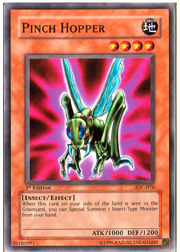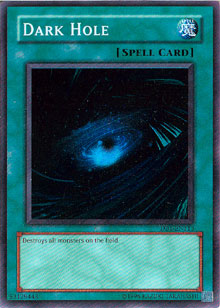“We can no longer ignore their unmatched battle prowess.”
Insects have made a gradual power progression that began with Man-Eater Bug from the early days of Legend of Blue-Eyes White Dragon, and the progression has escalated with more recent additions like Ultimate Insect LV7 from The Lost Millennium. As a team, Insects have a variety of effects that can be a lot of fun.
But these fun cards can also have not-so-fun rulings, especially when timing gets involved. We’ll begin our look into Insects with one of their most confusing monsters, Pinch Hopper, and then look at one of their strategic monsters, Insect Princess.
Pinch Hopper
 Pinch Hopper can be found in Dark Revelations 2. Its effect appears deceptively simple, but its timing restrictions can be very daunting.
Pinch Hopper can be found in Dark Revelations 2. Its effect appears deceptively simple, but its timing restrictions can be very daunting.
“When this card on your side of the field is sent to your Graveyard, you can Special Summon 1 Insect-Type Monster from your hand.”
Pinch Hopper doesn’t care how you send it from your side of the field to your graveyard. It also doesn’t care whether it’s face up or face down when this occurs. However, it does care about when this occurs.
Pinch Hopper’s effect falls into the category of optional trigger effects, meaning you will have to time its effect properly or lose it entirely. Usually this means that the act of sending Pinch Hopper to the graveyard needs to be the very last thing that happens at the end of a chain’s resolution. With this mind, there are some actions you’ll want to avoid if you want to succeed in using Pinch Hopper’s effect.
—If Pinch Hopper is sent to the graveyard to pay the activation cost of a card, you will not be able to activate its effect.
—If Pinch Hopper is tributed to summon a monster, you will not be able to activate its effect.
—If Pinch Hopper is sent to the graveyard between steps in a chain’s resolution, you will not be able to activate its effect.
When we’re talking about monsters with optional trigger effects, examples are the surest way to make sense of their restrictions.
Example 1: Pinch Hopper Meets Dark Hole
 Eric has Pinch Hopper on his side of the field. His opponent has a few stronger monsters on her side of the field, and Eric knows Pinch Hopper isn’t strong enough to take them down. Metal Armored Bug and Dark Hole are in Eric’s hand, and that’s all he needs to enact a plan.
Eric has Pinch Hopper on his side of the field. His opponent has a few stronger monsters on her side of the field, and Eric knows Pinch Hopper isn’t strong enough to take them down. Metal Armored Bug and Dark Hole are in Eric’s hand, and that’s all he needs to enact a plan.
He activates Dark Hole. His opponent has no response, so the chain resolves, and Dark Hole destroys every monster on the field, including Pinch Hopper. With nothing further on the chain, the timing is right for Eric to activate Pinch Hopper’s effect, allowing him to special summon Metal Armored Bug from his hand.
Example 2: Smashing Ground Interrupt
Mary activates Smashing Ground, intending to destroy her opponent’s only monster. Her opponent responds to Smashing Ground by activating Ring of Destruction, targeting Mary’s Pinch Hopper.
When this chain resolves, Ring of Destruction resolves first and destroys Pinch Hopper, sending it to the Graveyard. At this point, Mary would like to activate Pinch Hopper’s effect, but she cannot because the chain is still resolving. Unfortunately for Mary, after her Smashing Ground resolves, it will be too late to activate the effect of her Pinch Hopper, because the timing has passed.
Example 3: Paying a Cost
Van activates Enemy Controller and chooses to use its second effect, Tributing Pinch Hopper to pay the activation cost. Doing this allows him to take control of his opponent’s monster, but it also prevents him from activating Pinch Hopper’s effect.
Example 4: The Tribute Summon
Talia tributes her Pinch Hopper in order to summon a high-level monster. At this point, she would like to activate Pinch Hopper’s effect, but she can’t, because she hasn’t completed the summon. After summoning her high-level monster, the timing to activate Pinch Hopper’s effect is lost, because the last thing that happens is the tribute summon of a monster and not Pinch Hopper being sent to the graveyard.
Sometimes monsters with similar timing requirements will be simultaneously sent to the graveyard with Pinch Hopper. If this occurs, Pinch Hopper’s effect can still be activated, and this will usually result in the formation of a chain.
Example 5: Dark Hole Returns
We return to Eric’s situation, but this time one of his opponent’s monsters is Sangan. When Sangan and Pinch Hopper are both destroyed by Dark Hole, their respective effects both want to activate. Since Eric is intent on using the effect of Pinch Hopper, the two effects form a chain. Sangan is placed onto the chain first, because it’s the mandatory trigger effect. Pinch Hopper is placed onto the chain next, because it’s the optional trigger effect.
The Princess
 Our final card for today is Insect Princess. Reprinted in Dark Revelations 2, Insect Princess can prevent your opponent from entering into a defensive position, but it needs the right combination.
Our final card for today is Insect Princess. Reprinted in Dark Revelations 2, Insect Princess can prevent your opponent from entering into a defensive position, but it needs the right combination.
“While this card is face-up on the field, battle positions of all face-up Insect-Type monsters on your opponent's side of the field are changed into Attack Position. Each time this card destroys an Insect-Type monster as a result of battle, increase the ATK of this card by 500 points.”
While dueling, you may run into the occasional Insect-type monster, but this won’t occur often enough to take full advantage of Insect Princess’s effect. In order to overcome this drawback, you’ll need to rely on cards like DNA Surgery. After using it to turn all monsters into Insects, you can begin to take advantage of Insect Princess.
While Insect Princess is face up on your side of the field, all of your opponent’s face-up Insect-type monsters become locked into attack position. This is certainly not an issue when he or she summons an Insect-type monster, but what happens when he or she sets one instead?
When you declare an attack against the set monster, it’s flipped face-up before you calculate damage. Once it’s flipped face-up, it falls under the effect of Insect Princess and is shifted into attack position. This shifting of its battle position will occur before you determine damage calculation and can alter the results of the battle. For example, if the set monster you attacked has a low ATK value, it will be shifted into a very weak position and could easily be destroyed by your attacking monster.
Insect Princess also has a dark side. Every time it destroys a monster in battle, it feeds off its power and grows larger, gaining an extra 500 ATK. It begins at 1900 ATK, which is somewhat low for a level 6 monster, but destroy just one monster in battle, and that ATK grows to 2400. It will only grow larger from there.
You can earn a similar effect from Millennium Scorpion in The Lost Millennium. While it may lack the control effect of Insect Princess, it makes up for this by being a level 5 monster with 2000 ATK.
How does being a level 5 monster improve things? Return here next week for the answer, when we’ll take a look at a classic card from the Pharaoh’s Servant expansion set. I will also introduce a few more Insect cards for your consideration, including the ravenous Insect Queen.
Send all comments and questions to Curtis@metagame.com.